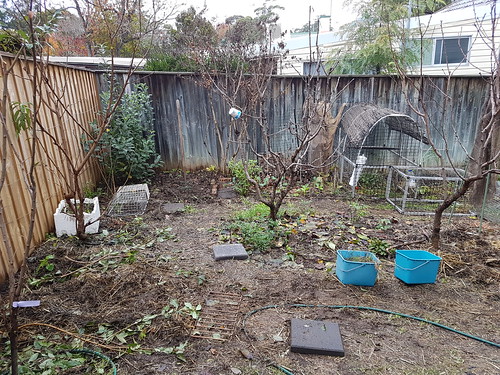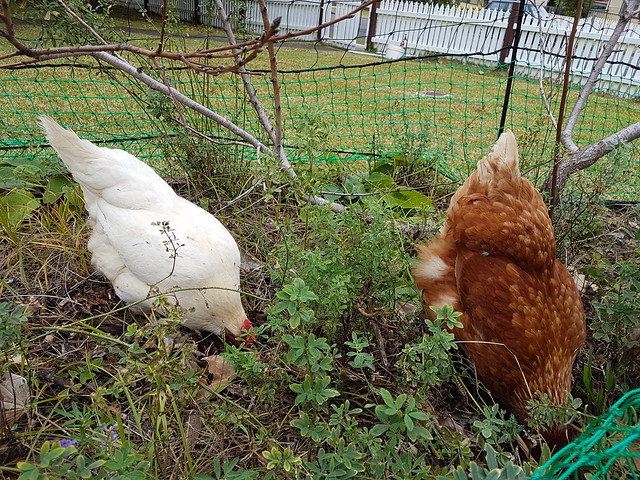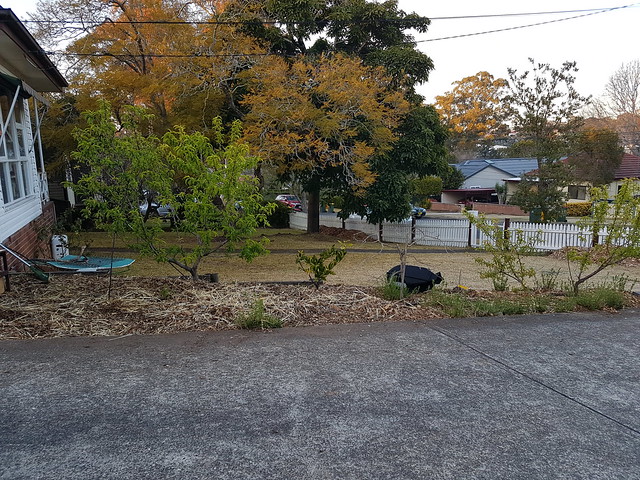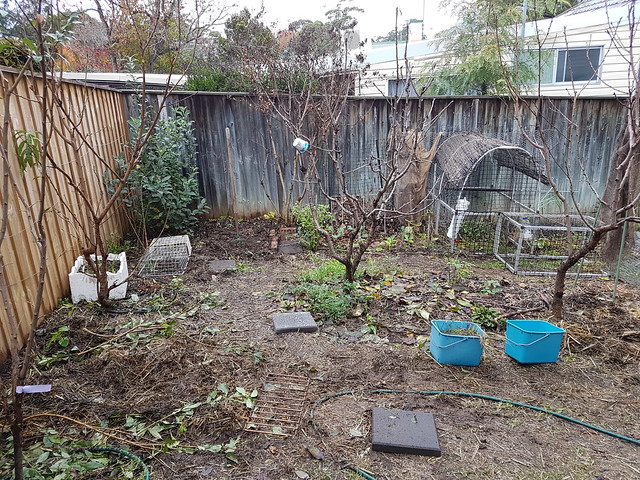But we got SO MUCH done!
1. Permanent chook run
Ironically, while this was something I particularly wanted completed, it didn't get finished. It didn't even get started, due to the one thing which I'd casually earmarked as 'necessary but not an actual task' turning out to be seriously labour and time-intensive!
I'll talk about this at the end of the list.
2. connect up rainwater tanks
This was beautifully done! Two linked 60L barrels set on a platform with a tap installed so the water can be bucketed elsewhere, or channelled down a hose to the orchard!

3. make composting bioreactor
At first the bioreactor was difficult because nobody had seen it done before. However, after I got my laptop out and showed the taskgroup the video of the Johnson-Su bioreactor, they got the gist of it, and things proceeded pretty well.
A compost bioreactor is essentially a 'set and forget' compost that's supposed to be very rich in fungal nutrients because it doesn't get turned to aerate, thereby requiring the biota to readjust when everything is turned over. Instead of turning, six 'air columns' run through the middle of the pile, allowing the bacterial to breathe and do their thing. It takes a while to break down (some 5-6 months was the estimate) but the results are excellent, and not having to turn it means you can create several of these around the yard and deplete one while others do their thing.
Bare space where the bioreactor is going:

They put down a wooden pallet on bricks (to keep it from rotting) and then positioned the bioreactor on top.
Completed but lidless bioreactor on the day:

The bioreactor contents were basically two garbage bags of horsemanure, two containers of guineapig litter, one container of chook litter, and a helluvalot of chip mulch.
A day later, with the pipes pulled out to leave the airholes, and a 'lid' on top to keep the moisture in.

Two days later, with a water barrel that gets filled with the 'waste shower water' that fills up a bucket while showering, and which seeps into the compost to keep it moist:


This one, more than the other projects, will probably have pictures in future, so others can see what it looks like as it breaks down over time.
4. (move lattice and) set up composting bays
The front and back yards of the house were previously defined by the position of a lattice that ran in line with parts of the house. It left a gap behind the shed of about 1.2m, enough for a composting space, but not a very easy place to work. I wanted the lattice moved forward to run in line with another corner of the house, and a couple of compost bays set up behind the shed.
Late on Sunday afternoon:

This afternoon (Wednesday):

The idea of the composting bays is to have something that regularly gets added to. Paper wastes, vegetable wastes unsuitable for the worms or chooks, possibly chook manures. It will require turning after a while, but right now, it's just settling with the compost that was made on Sunday (left-hand bay) and the pine-and-banksia woodchip mulch that I've been filling the right-hand bay with for the last couple of days. We'll see about the results - ideally, there should be more 'green'/nitrogenous wastes to make a hot compost, but the chips are only about 4 days old and might still have some decomposing to do. Either way, neither of these composts is likely to be much use for a few months at least.
5. empty, move, and refill vegepod
This took somewhat longer than I expected; I was just expecting a move-to-a-new-location, but the wonderful women working on this task went about not only repositioning my vegepod and making sure it was flat and supported and positioned to my satisfaction, but also turned it into a wicking bed. Which I kind of wanted, but didn't figure I had the time/materials to do.
Well, they found the time and scrounged the materials, and although this meant that the task took longer than expected, it's a wonderful surprise and will be extremely useful!

Next week, I'll plant out the melons, cucumbers, tomatoes, eggplants, and mild/sweet peppers that I've been growing for the last month, and set up some wires to run up to the roofline. The goal is to get the vines growing up those wires to give a little shade to the house in the coming months of hot northerly sun...
6. set up bathtub gardens
We moved the bathtubs, and that was about it. I needed to seal up the holes in the tubs, and I haven't. But they're in the location I've envisioned, now I just have to get them sealed and re-positioned, and then we can add what goes in them. One water garden, one above-ground garden - possibly a wicking bed.

Unexpected
Team Chook Pen had the task of not only creating a run for the chooks, but moving two lattices (one of them blocking the area for the compost bay) and combining them into a single fence.
I put this down as a throwaway line - in brackets - a task that needed to be done in order to get around to the chook pen.
It took ALL DAY.
Out of all the tasks, this was the most time-intensive one! Taking the lattices apart, digging out the fenceposts, digging the new post holes, putting it all back together... A team of five or six started when the bee began, around 10am, and it was pretty much the very last thing to be completed around 4:30pm.
WOW!
But the result is also WOW!


Overall, that is easily several months (if not several years) worth of work done in a single day by dedicated teams of people who love gardening. The old adage "many hands make light work" precisely sums it up!
The non-existent chook pen is a bit of a pain, but I have a reasonable idea of how to go about it now, I just have to kick myself into actual gear in the next couple of weeks...
I'm thinking about applying for a permabee next year, too - this one to simply plant out a food forest along the picket fence line...












